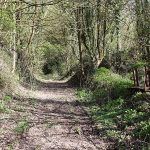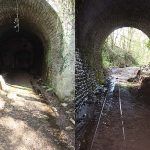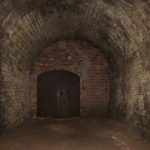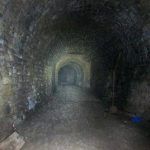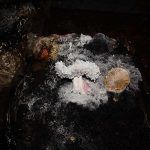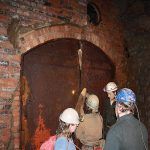Euroclydon Tunnel
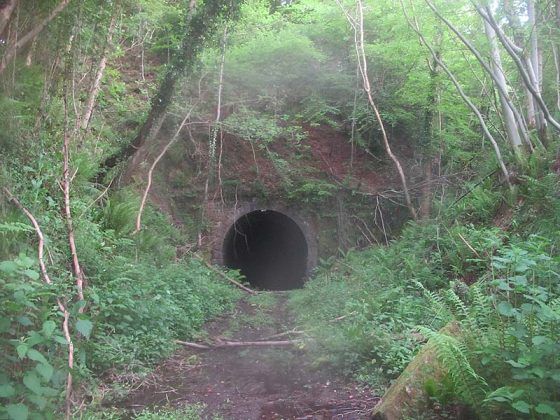
More correctly know as Hawthorns Tunnel, this 638 yard tunnel is normally securely locked at both ends to prevent casual access. We have been allowed special access to the tunnel to check on the long term possibility of running trains through it. I would say “again” but it apart from the odd engineering train it is almost as new and not smoke stained as normal. Under the pictures is an account of working in the tunnel more than 60 years ago.
Admiralty munition storage facility,
Hawthorns (Euroclydon) tunnel, Drybrook
Yesterday afternoon with Rob and Yuehong Dickinson, I visited Edgar Tippins of Lea Bailey, Herefordshire at the invitation of his daughter, Caroline Probert. The purpose of the visit was to hear and record his memories of working in the tunnel in 1947 and 1948, when the Admiralty was still using it for storage of munitions. Mr. Tippins was born in 1924 and has lived in the area all of his life, having been born at home in Drybrook. As he worked as a miner in the Arthur and Edward pit, Lydbrook, for seven years he could have registered as a freeminer, but he didn’t bother.
In the Admiralty facility he was one of a team of about a dozen workmen, most of whom were older than him, so he could well be the last living member of the team. There was a foreman in charge of the team, which was under the control of a manager in Malvern who visited the facility each week to hand out wage packets. The facility was used to store depth charges, torpedoes and mines, received from ROF Swynnerton, Staffs, (No 5 filling factory, which seems to have been connected with the Royal Navy, although producing a wide range of munitions) and ROF Glascoed, Gwent, (which produced sea mines for the Royal Navy). These were brought to the facility on standard gauge trains, via the GWR branch from Bullo Pill (near Newnham) to Cinderford. The trains were normally of up to seven or eight assorted wagons, which could be open wagons with the load covered by a tarpaulin or vans, and were hauled by a small engine, presumably a GWR tank engine. When the Admiralty took over the tunnel, they had laid concrete slabs through the tunnel and installed a narrow gauge railway (widely reported to be 18in gauge) – there is a single picture in Pope and Karau’s Wild Swan book on the Forest of Dean Branch. The munitions were transferred from the standard gauge to narrow gauge wagons in a barn-like transfer shed with platforms for the two gauges at the same height for easy transfer. There were three grounded coach bodies for the staff’s use – these included some female clerical staff.
The narrow gauge track ran into the tunnel on the right hand side and went the full length to the far end. At each end of the tunnel was a blast wall. Wagons on the narrow gauge were hauled by one of two battery electric locomotives, normally one being in use while the batteries of the other were being charged. Edgar’s work included checking and topping up the fluid level in the lead acid batteries. Each locomotive was approximately 3ft 6in wide and 8ft long. One was apparently taller than the other, and Edgar felt that the taller one seemed to be top-heavy. The munitions were transported on small (i.e. 4 wheel) flat wagons, not more than five or six at a time (one munition per wagon, up to 5 or 6 wagons at a time). He thought that the gauge was 2ft rather than 18in, but admitted that he wasn’t sure.
At each end of the tunnel an area was enclosed with ‘unclimbable’ steel fencing (rusting remains of which still survive in situ). Outside each tunnel portal was a hut for a security guard (apparently manned 24 hours a day, as there was a night watchman as well as the daytime guard). The purpose of the guard seems to have been to prevent unauthorised access to the tunnel as beyond the hut but within the fenced perimeter at the northern end of the tunnel was a larger shed known as the ‘lab’. In the tunnel there were concrete plinths on the left hand side (when facing north) to raise the storage racks above the wet floor of the tunnel. On these plinths were mounted vertical steel girders to support the racks on which the munitions were stored. (The plinths with mounting points for the girders plus a few of the girders are still obvious in the tunnel.) Torpedoes and depth charges were stored towards the Drybrook end with mines stored towards the other end of the tunnel. All munitions were stored without fuses, mainly in sealed wooden boxes. The whole tunnel was illuminated by small electric light bulbs.
There was apparently a regular movement of munitions into and out of the facility. The team also were responsible for routine care of the munitions, including removing old protective paint and re-painting. Tools used were brass, to prevent any sparks being caused.
This is my summary of over an hour’s conversation with Edgar as he remembered working in the Euroclydon tunnel. (Note – the tunnel is variously known as either Euroclydon, after the house above it which was built by a member of the well-known Brain family of colliery owners, or Hawthorns, after the name of the area above the tunnel.) The conversation was recorded by Yuehong on video.
Rob Needham, 4th October 2012
